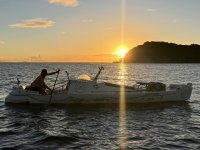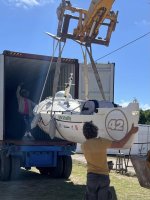
“I crossed the ocean to see the power that makes the world go round,” the 44-year-old athlete wrote on Facebook on Sunday, having reached Antigua on Saturday evening (Hungarian time) after 5,123 kilometers, and remarked that this was his second ocean crossing in the world, after his 77-day trip in 2012.
Originally designed and built by Nándor Fa, Rakonczay rebuilt the boat based on his experience in 2012, adding a new cabin, capital weight, steering system, and state-of-the-art technical equipment.
Here is a Hungarian news report of his trip last month, which has an embedded video and Facebook links:

Gábor Rakonczay Completes Solo Atlantic Crossing in Canoe
Extreme athlete Gábor Rakonczay completed his last expedition in 75 days and 10 hours, during which he crossed the Atlantic Ocean alone in his canoe, and as he said, his career has now come to an end. “I crossed the ocean to see the power that makes the world go round,” the 44-year-old athlete...
Here is a website devoted to the similar trip Rakonczay completed in 2012:

Szóló transzatlanti kenuzás | Rakonczay Gábor extrém sportoló
Az Atlanti-óceán kelet-nyugat irányú (transzatlanti) átkenuzása Rakonczay Gábor által egyedül, a világon elsőként.

